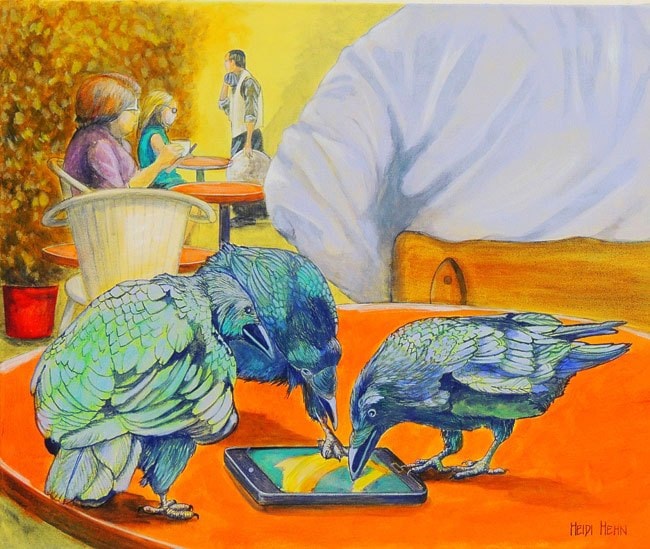On the video, a white-necked raven is perched on the arm of its keeper.
“Mischief, can you say hello?”
“Hello,” replies the bird.
“Can you say, hi?” she asks later in the recording.
“Hi.”
In the world of birds, parrots get most of the credit for being the chatterboxes. But ravens, a common sight for anyone living in the North, have also shown the ability to mimic the people they hear around them.
Ravens, it turns out, may force us to redefine what it means to be a birdbrain.
Whitehorse artist Heidi Hehn’s latest show of acrylic paintings, Raven Mad, showcases the mind of this clever bird and all the skills and tricks it uses to adapt and survive.
“All animals are smart but ravens are smarter than most because they live around us, they learn quickly, and they know how to test to get the results that they’re looking for to find out what’s going on,” she says.
Ravens have fascinated scientists. Studies appear to show ravens using logic to solve problems. In one test the birds were left with a piece of meat hanging off a string tied to a tree branch.
The birds would have to pull on the string repeatedly, gathering up the excess with their claws as they went, in order to reach the treat at the other end.
It’s hardly a scenario these birds would come up against in their everyday life and still some adult ravens completed the multistep process in less than 30 seconds.
There was no trial and error, according to news reports on the study. It was like the birds knew exactly what they were doing.
Ravens have been found to have their own social structure and hierarchy.
Hehn said ravens have been seen pulling on a bear’s tail, in what appears to be an attempt to learn what would happen and store that bit of knowledge for the future.
“They’re the greatest little scientists there are.”
They have to be smart to survive, Hehn said.
“They have to use their brains. They’re stuck using those brains and those brains are pretty sneaky.”
In the 15 vibrant pieces that make up her show, Hehn captures some of the things she’s seen ravens doing, or imagined they would do, given the opportunity.
“It just kept evolving into the whole idea that ravens reflect so much of our society because they live so close to us, they’re taking advantage of everything they can,” she said.
It could be as simple as wanting a hot meal for dinner.
Hehn imagined, and later saw photos of, ravens riding on a truck as it goes through a fast food drive-thru.
That became a piece titled Fast Foodies. In the painting ravens are perched on the back of a bright red pick-up as the driver picks up a bite to eat.
After all, why wait for the food to get cold coming out of the dumpster?
“Another animal might find that actually dangerous, even a human being might find that kind of dangerous, (but) they’ll do that
- they’re adapting always to what we have out there that looks like they can gain from it.”
In another piece, painted mostly in bright blues, yellows and oranges, Hehn depicts ravens examining someone’s smartphone.
“I don’t know, I just had to do it. I’ve never seen it happen but I bet if I put a smartphone on a table the ravens would be there and they’d know how to use it in no time,” she said.
“But I’m not willing to sacrifice my smartphone to do it.”
The way ravens adapt can serve as a mirror to show how humans change, Hehn said.
“And besides,” notes the show’s description, “in the long dark winter months it is nice to have someone to socialize with that’s just as mad as we are!”
Raven Mad begins April 1 at the North End Gallery. The closing reception is on April 29.
Contact Ashley Joannou at ashleyj@yukon-news.com
